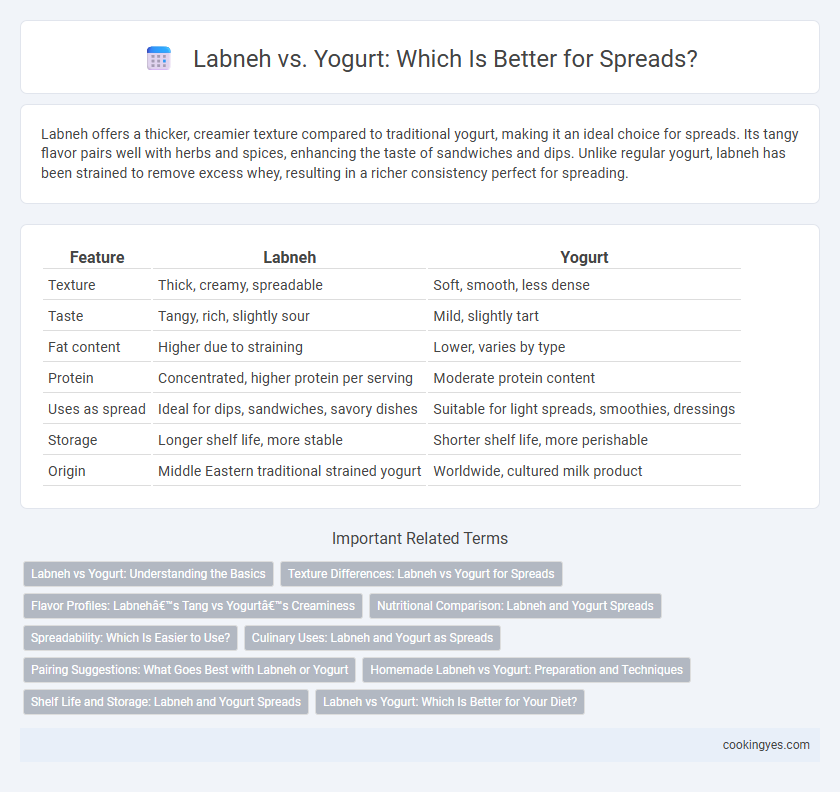Labneh offers a thicker, creamier texture compared to traditional yogurt, making it an ideal choice for spreads. Its tangy flavor pairs well with herbs and spices, enhancing the taste of sandwiches and dips. Unlike regular yogurt, labneh has been strained to remove excess whey, resulting in a richer consistency perfect for spreading.
Table of Comparison
| Feature | Labneh | Yogurt |
|---|---|---|
| Texture | Thick, creamy, spreadable | Soft, smooth, less dense |
| Taste | Tangy, rich, slightly sour | Mild, slightly tart |
| Fat content | Higher due to straining | Lower, varies by type |
| Protein | Concentrated, higher protein per serving | Moderate protein content |
| Uses as spread | Ideal for dips, sandwiches, savory dishes | Suitable for light spreads, smoothies, dressings |
| Storage | Longer shelf life, more stable | Shorter shelf life, more perishable |
| Origin | Middle Eastern traditional strained yogurt | Worldwide, cultured milk product |
Labneh vs Yogurt: Understanding the Basics
Labneh is a strained yogurt spread with a thicker, creamier texture and higher protein content compared to regular yogurt. While yogurt has a tangy flavor and loose consistency suited for drinking or cooking, Labneh's concentrated dairy solids make it ideal for spreading on bread or crackers. Nutritionally, Labneh offers a richer source of probiotics and essential nutrients due to its straining process.
Texture Differences: Labneh vs Yogurt for Spreads
Labneh offers a thicker, creamier texture compared to yogurt, making it ideal for spreads that require a dense consistency. Yogurt tends to be lighter and more fluid, providing a softer, smoother spread but less structural stability. The concentrated milk solids in labneh result in a spread that holds its shape better on bread or crackers, enhancing the eating experience.
Flavor Profiles: Labneh’s Tang vs Yogurt’s Creaminess
Labneh offers a distinctive tangy flavor that enhances savory spreads, creating a bold and rich taste experience ideal for Mediterranean cuisine. Yogurt, known for its smooth creaminess, provides a milder, subtly sweet base that blends well with both sweet and savory toppings. Choosing labneh or yogurt for spreads depends on the desired balance between intense tanginess and smooth creaminess in flavor profile.
Nutritional Comparison: Labneh and Yogurt Spreads
Labneh contains higher protein content and lower lactose levels compared to traditional yogurt, making it suitable for individuals with lactose sensitivity. Both labneh and yogurt are rich in probiotics and essential nutrients like calcium and vitamin B12, but labneh has a thicker texture due to its concentrated whey removal. Labneh's higher fat content also provides a creamier consistency, enhancing its suitability as a nutrient-dense, savory spread option.
Spreadability: Which Is Easier to Use?
Labneh offers a thicker, creamier texture compared to traditional yogurt, making it easier to spread evenly on bread or crackers. Its concentrated consistency holds shape better, reducing dripping and mess during use. Yogurt, especially when strained less, tends to be runnier and less manageable as a spread.
Culinary Uses: Labneh and Yogurt as Spreads
Labneh offers a thicker, creamier texture compared to yogurt, making it ideal for rich, tangy spreads on breads and crackers. Yogurt, especially Greek yogurt, provides a lighter, more versatile spread option that blends well with herbs and spices for dips. Both labneh and yogurt enhance culinary applications by adding probiotics and a balanced acidity to savory and sweet dishes.
Pairing Suggestions: What Goes Best with Labneh or Yogurt
Labneh pairs exquisitely with robust flavors like za'atar, olive oil, and fresh herbs such as mint or thyme, making it ideal for savory spreads on pita or crackers. Plain yogurt complements sweeter accompaniments like honey, fresh berries, and granola, enhancing its creamy texture with a subtle tang. Both labneh and yogurt can also balance spicy dishes, with labneh suited for Middle Eastern spice blends and yogurt preferred alongside Indian curries.
Homemade Labneh vs Yogurt: Preparation and Techniques
Homemade labneh is prepared by straining yogurt through a fine cloth for 24 to 48 hours, resulting in a thicker, creamier consistency ideal for spreads. Yogurt used as a spread typically requires minimal preparation, often served plain or slightly thickened by chilling. Labneh's straining process removes whey, intensifying its tangy flavor and creating a richer texture compared to the looser, creamier texture of standard yogurt spreads.
Shelf Life and Storage: Labneh and Yogurt Spreads
Labneh offers a longer shelf life compared to regular yogurt spreads due to its thicker consistency and lower moisture content, making it less prone to spoilage when stored properly. Both labneh and yogurt spreads should be refrigerated at temperatures below 40degF (4degC) to maintain freshness and prevent bacterial growth. Properly sealed containers can extend the usability of labneh up to two weeks, while yogurt spreads generally last about one week under similar storage conditions.
Labneh vs Yogurt: Which Is Better for Your Diet?
Labneh contains higher protein and lower sugar than regular yogurt, making it a nutrient-dense option for spreads. Its creamy texture and tangy flavor provide a satisfying alternative with fewer carbohydrates and probiotics beneficial for gut health. Choosing labneh over yogurt can support weight management and enhanced satiety in a balanced diet.
Labneh vs yogurt for spreads Infographic

 cookingyes.com
cookingyes.com